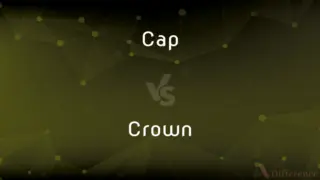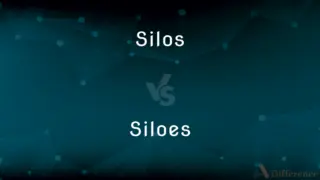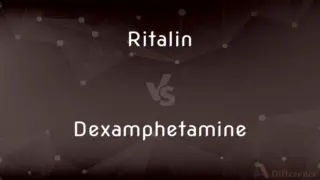Schizont vs. Trophozoite — What's the Difference?
By Urooj Arif & Fiza Rafique — Updated on April 16, 2024
Schizonts are a developmental stage in the life cycle of parasites, focusing on replication, while trophozoites are active feeding stages in protozoan life cycles.

Difference Between Schizont and Trophozoite
Table of Contents
ADVERTISEMENT
Key Differences
Schizonts represent a stage in the lifecycle of parasitic protozoans where the organism multiplies internally, often within the host's red blood cells. Whereas trophozoites are generally the metabolically active stage where the parasite feeds and grows.
During the schizont stage, the parasite undergoes multiple nuclear divisions without actual cell division, leading to the formation of merozoites. On the other hand, trophozoites often engage in feeding and growth, absorbing nutrients directly from the host.
In the case of malaria, schizonts can cause the rupture of host cells, releasing merozoites that infect new red blood cells. Conversely, trophozoites in amoebic dysentery actively invade host tissues, causing damage and symptom manifestation.
Schizonts are typically found in the liver of the host, depending on the parasite's species and lifecycle stage. Trophozoites, however, are often found in various body sites, including the intestine, liver, adapting to diverse environments.
The detection of schizonts in diagnostic tests often indicates an ongoing infection and can be critical for diseases like malaria. In contrast, finding trophozoites, especially in stool samples, is key to diagnosing diseases like amoebiasis.
ADVERTISEMENT
Comparison Chart
Stage in Lifecycle
Reproductive, pre-division
Active growth and feeding
Function
Preparation for reproduction
Nutrient absorption and assimilation
Location
Often in host's red blood cells or liver
Can be in intestine, liver, or circulating blood
Associated Diseases
Malaria, babesiosis
Amoebiasis, giardiasis
Diagnostic Relevance
Indicates high parasitic load
Indicates active infection
Compare with Definitions
Schizont
Contains multiple nuclei before cell division.
Schizonts in the liver will soon release merozoites.
Trophozoite
Active, feeding stage of protozoans.
Giardia trophozoites cause symptoms by damaging the intestinal wall.
Schizont
A stage in the parasite lifecycle focused on replication.
The malaria parasite forms schizonts inside red blood cells.
Trophozoite
Directly absorbs nutrients from the host.
Trophozoites thrive by utilizing nutrients from the host's gut.
Schizont
Precedes the release of invasive forms of the parasite.
Detecting schizonts is crucial for early malaria treatment.
Trophozoite
Identified in stool samples for diagnosis.
Finding trophozoites in stool is definitive for amoebiasis.
Schizont
Typically not found in early infections.
Schizonts develop after the initial liver stage in the malaria lifecycle.
Trophozoite
Morphologically distinct from other stages.
Trophozoites often have a characteristic shape or form, aiding identification.
Schizont
Indicates severe infection when detected.
High schizont count often correlates with severe malaria symptoms.
Trophozoite
Can cause tissue damage in host.
Amoebic trophozoites can lead to liver abscesses.
Schizont
An apicomplexan cell formed by schizogony.
Trophozoite
A trophozoite (G. trope, nourishment + zoon, animal) is the activated, feeding stage in the life cycle of certain protozoa such as malaria-causing Plasmodium falciparum and those of the Giardia group. (The complement of the trophozoite state is the thick-walled cyst form).
Schizont
A cell that divides by schizogony.
Trophozoite
An elongated cell that develops from a sporozoite or a merozoite of an apicomplexan parasite and that feeds and grows within the host.
Schizont
In certain Sporozoa, a cell formed by the growth of a sporozoite or merozoite (in a cell or corpuscle of the host) which segment by superficial cleavage, without encystment or conjugation, into merozoites.
Trophozoite
A protozoan in the feeding stage of its life cycle.
Trophozoite
A sporozoan in the active feeding stage of its life cycle
Common Curiosities
How does a schizont differ from a trophozoite?
Schizonts are focused on internal replication and are a precursor to cell division, whereas trophozoites are active, feeding stages.
Can schizonts be seen in early infection stages?
Schizonts typically appear after the initial stages of infection, such as the liver phase in malaria.
What is a schizont?
A schizont is a stage in some parasitic protozoans where the parasite multiplies internally before cell division.
What role do trophozoites play in infections?
Trophozoites are responsible for absorbing nutrients from the host and can directly cause tissue damage.
What diseases are associated with schizonts?
Diseases like malaria and babesiosis involve the schizont stage in their lifecycle.
What diseases are associated with trophozoites?
Diseases such as amoebiasis and giardiasis are known for their trophozoite stages.
Are trophozoites always harmful?
While trophozoites are associated with pathogenic activity, their effect varies depending on the organism and host conditions.
Is it possible to have a disease with only trophozoites detected?
Yes, diseases like giardiasis may primarily show trophozoites during active infections.
Why is it important to distinguish between schizonts and trophozoites?
Identifying these stages helps tailor treatment approaches and understand the infection’s progression.
How can one prevent diseases associated with schizonts and trophozoites?
Preventive measures include proper sanitation, water treatment, and in some cases, prophylactic medication.
What treatment is effective against schizonts?
Antimalarial drugs are specifically designed to target schizonts and prevent malaria progression.
How are trophozoites treated?
Treatments may include antimicrobial agents that target the active stages of protozoans like trophozoites.
Are schizonts visible to the naked eye?
Schizonts are microscopic and require lab tests for detection.
Share Your Discovery

Previous Comparison
Rat vs. Chipmunk
Next Comparison
Glanders vs. StrangleAuthor Spotlight
Written by
Urooj ArifUrooj is a skilled content writer at Ask Difference, known for her exceptional ability to simplify complex topics into engaging and informative content. With a passion for research and a flair for clear, concise writing, she consistently delivers articles that resonate with our diverse audience.
Co-written by
Fiza RafiqueFiza Rafique is a skilled content writer at AskDifference.com, where she meticulously refines and enhances written pieces. Drawing from her vast editorial expertise, Fiza ensures clarity, accuracy, and precision in every article. Passionate about language, she continually seeks to elevate the quality of content for readers worldwide.











































